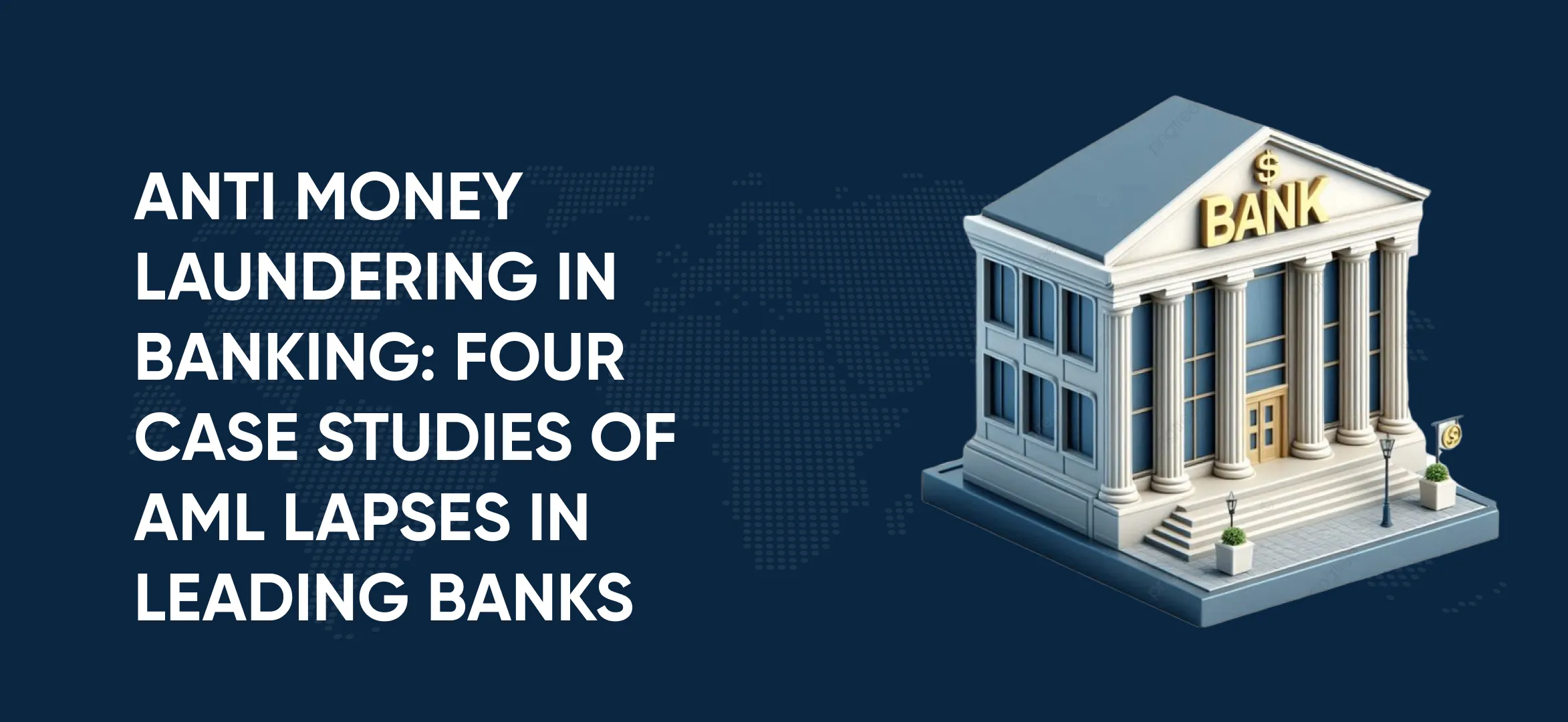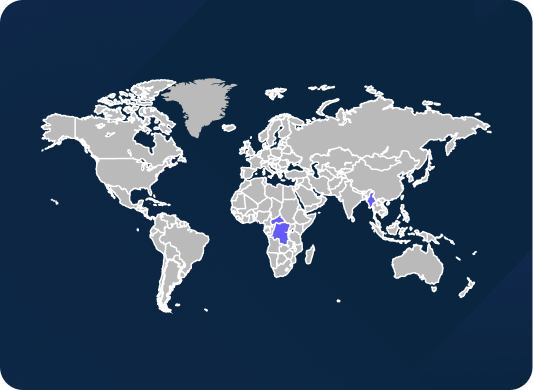
Anti Money Laundering in Banking: Four Case Studies of AML Lapses in Leading Banks

The evolution of digital financial services to facilitate 360 million online banking users in Europe followed by North America with 240 million active users is in dire need of parallel functional AML in banking sectors.
Having these stats mentioned, a question like ‘What is AML in Banking’ can be answered in a subtle way where anti money laundering in banking is defined as a systematic approach to fight financial crimes through orchestration of effective AML compliance measures. The effectiveness of these measures is evaluated and governed by the law enforcement and regulatory bodies across the globe.
Note: Read more about working of AML in banking sectors with its alarming challenges in a changing regulatory environment.
Money laundering with its deteriorating nature costs around $300 billion to the U.S economy which triggers the most rigid enforcement actions by the Department of Justice amounting to half of the total global AML and sanctions non-compliance cost ($14 billion).
The banking industry sees no bound to the flow of money, therefore the vigilance of AML protocols can not be overlooked by the regulators and institutions. If overstated, the compliance can bring institutional grace to fall as we will examine the tales of AML compliance and its lapses in four prominent banks.
Leaving the conclusion to your instinct, these case studies will shed light on the compliance challenges faced by the infamous financial institutions and how AML shortfalls could be prevented if they had that extra eye to identify bad guys. Before delving into it, I want to pin down a famous saying of Benjamin Franklin that stands true even today.
“He that is of the opinion money will do everything may well be suspected of doing everything for money.”
The Danske Bank in Trembling Tale of Compliance
Levied with a fine of a total of $2 billion, in Dec 2022, the Danske Bank came in a global settlement with Denmark’s Special Crime Unit, the United States Attorney’s Office for the Southern District of New York, the Department of Justice, and Securities and Exchange Commission (SEC) upon facing shortfalls of AML compliance measures.
Compliance Failures & Allegations
According to the SEC, the alleged bank, after acquiring its Estonian branch in 2007, overlooked the money laundering risks associated with numerous transactions initiated by the non-resident customers of Estonia.
The ineffectiveness of the AML banking process made it difficult for the bank to ensure effective anti-money laundering (AML) and know your customer (KYC) protocols which lead to inefficient risk management and unaligned AML regulations.
In spite of making efforts to gauge AML risks, the SEC found significant gaps in the bank’s reporting measures which changed the compliance and market status of the bank when the allegations surfaced.
Applicable to all institutions, the Danske Bank was found struggling with conveying its AML compliance strengths to the investors which lead to the accusations of misleading the shareholders and hence the violation of the Securities Exchange Act of 1934, stated by the Director of SEC.
Four Prominent AML Measures that Could Redefine Bank’s Integrity
Despite the challenges and dynamic regulatory needs, the bank’s efforts to fight financial crimes and avoid non-compliance could have been strengthened with the adaptation of following AML measures.
Enhanced due diligence and a risk based approach to screen and monitor high-risk profiles was the way out to proactively identify risks and AML threats.
Transaction monitoring to suspect unusual and irregular transaction patterns could have empowered the bank’s compliance in mitigating the risk of money laundering.
Biometric AML and name screening, had it placed in the existing compliance tools, efficient screening measures would allow the compliance team to detect suspicious actors in the global watchlists of sanctioned and blocked persons.
AML audits and structured reporting protocols could have enhanced the in-house compliance through identifying the loopholes of anti-money laundering measures and AML case management.
The Standard Chartered Bank under Sanctions Compliance Challenges
A public notice released by the U.S Department of Justice (DOJ) announced that the Standard Chartered Bank (SCB) came down to a settlement to forfeiture of $240 million, an extended DPA (deferred prosecution agreement) of two years, and a fine of $489 million. The bank was accused of facilitating thousands of financial transactions for sanctioned entity Iran with apparent violations to IEEPA (International Emergency Economic Act), said the investigators at DOJ.
Addressed Shortfalls of AML Compliance at SCB
Struggling to meet anti money laundering and sanctions compliance in an evolving regulatory landscape is a real world challenge. After the resolution of the charges, SCB took responsibility for its weak compliance framework and adopted extended compliance measures while setting a compliance bar for financial institutions to stem money laundering in banking systems.
Leaving the AML deficiencies in the past, a robust compliance program at SCB must include, not limited to, the following AML considerations.
Enhanced internal controls and functional AML policies to train the compliance team and be aware of the employees attitude towards compliance protocols.
An efficient customer due diligence coupled with proper AML/KYC measures that empower the bank’ compliance through proactive approach in onboarding foreign clients.
Instigation of advanced technology to streamline the AML screening process and align with momentarily changing sanctions check requirements.
The Nordea Bank With Its AML Compliance Anatomy
Reported by the OCCRP (Organized Crime and Corruption Reporting Project) and a Danish newspaper, the Nordea bank was accused of facilitating money laundering activities worth €700 million involving Russia and Soviet states.
The allegations were revealed in a report named ‘laundromat’ which highlighted leaked documents of weak AML compliance by several banks in the Nordic region. Amid the money laundering allegations, a fall in the share prices of Nordea was closed down to 4%.
To address the accusations of falling AML in banking, “We recognize that our systems in the past may not have been robust enough to counter this sort of financial crime. For that we are truly sorry,” Nordea responded.
Which Three Urgent AML Measures Can Enhance Compliance at Nordea Bank?
The surfaced concerns of illicit money flow from Nordea is called to an action plan with enhanced AML procedures and measures. The prioritized compliance will not only empower the bank to meet regulatory requirements but restore the investors and consumers confidence. After taking a close look at the potential AML weaknesses occurring to the existing measures, following compliance enhancements can ensure the mitigation of AML risks.
Reassessment of the potential money laundering risks will help the financial institution take necessary steps to enhance the AML/KYC onboarding procedures and AML protocols at the bank.
A vigilant screening against sanctioned entities and due diligence for high-risk clients from regions with more potential to launder blocked funds can empower the institution to meet regulatory demands and uphold the reputation of its compliance framework.
Employment of automated AML screening tools coupled with ongoing monitoring and biometric verification can add an extra shield of defense against the money laundering opportunities unknowingly facilitated by the bank.
The HSBC in an AML Enforcement Venture
The U.S Department of Justice forfeited the HSBC (HSBC Holdings plc and HSBC Bank USA N.A.) with $1.256 billion and brought the group into a DPA for apparent violations of BSA (Bank Secrecy Act), IEEPA (International Emergency Economic Powers Act), and TWEA (Trading with the Enemy Act).
An Outlook on AML Compliance at HSBC
The developing and fragile AML compliance program at HSBC made it difficult for the institution to employ robust due diligence and customer monitoring. Encountered with several sanctions compliance challenges, the bank happened to perform transactions for its clients in Cuba, Iran, Sudan, Burma, and Libya, the sanctioned countries by the OFAC (Office of Foreign Assets and Control).
Motivated to implement a vigilant AML in banking and prevent such events in future, HSBC took responsibility for the unwanted conduct with mandatory AML reforms and changed senior management.
The incident of HSBC collapsed AML leaves a lesson for the global banking industry to reassess their compliance measures as the regulations will keep on changing but the compliance expectations will not.
Mandatory AML Reforms are the Only Way Forward for HSBC
Fostering an ethical compliance culture, HSBC needs to refurbish its AML controls by implementing the following inevitable changes in its compliance program.
Risk based approach coupled with enhanced due diligence is the key for financial institutions to build a resilience against financial crime actors.
Timely identification of irregular and suspicious transactions is possible through sturdy transaction monitoring and effective customer screening by employing technology and human resources.
Sanctions screening powered with continuous vigilance for regulatory changes and controlled transactions can enable the institution to implement sanctions compliance while upholding the reputation and integrity of the bank.
Having these cases analyzed, one might wonder about the future of AML banking compliance and how it will unfold itself with compliance challenges piling up day after day.
Is it Possible to Predict the Future of AML in Banking?
If we try to put it in a nutshell, combating the financial crimes knowingly or unknowingly facilitated by the financial institutions require a way around the increasing and complex compliance challenges. With a fair involvement of technology and human intervention through a collaborative approach presents a feasible solution to these evolving regulatory demands. The enforcement actions should not be the motivation behind AML compliance efforts but the establishment of a responsible financial culture can restore the falling integrity of the global financial ecosystem.
The procurement of AML consultancy and guidelines to better comprehend the specific compliance challenges can help institutions to overcome the obstacles.
Connect with AML Watcher to empower and maintain your compliance framework in an unforgiving regulatory environment.
We are here to consult you
Switch to AML Watcher today and reduce your current AML cost by 50% - no questions asked.
- Find right product and pricing for your business
- Get your current solution provider audit & minimise your changeover risk
- Gain expert insights with quick response time to your queries

 Compliance Guidelines: United Arab Emirates
Compliance Guidelines: United Arab Emirates
 Compliance Guidelines: Germany
Compliance Guidelines: Germany
 UK to Launch World’s First Sanctions Regime to Target Upstream People Smuggling
UK to Launch World’s First Sanctions Regime to Target Upstream People Smuggling
 Utah Lawsuit Alleges TikTok Livestreams Facilitated Money Laundering Activities
Utah Lawsuit Alleges TikTok Livestreams Facilitated Money Laundering Activities


 Why Should states conduct AML Due Diligence for CBI/RBI Investment Schemes?
Why Should states conduct AML Due Diligence for CBI/RBI Investment Schemes?
 How can businesses comply with US sanctions on vessels?
How can businesses comply with US sanctions on vessels?
 Difference In AML: DNFBPs Vs Financial Sector
Difference In AML: DNFBPs Vs Financial Sector
 Difference in EU and US Sanctions Programs - How It Impacts Compliance?
Difference in EU and US Sanctions Programs - How It Impacts Compliance?
 How Regulatory Gaps Fueling Money Laundering in High Risk Jurisdictions?
How Regulatory Gaps Fueling Money Laundering in High Risk Jurisdictions?
 Mapping Anti-Money Laundering Regulations in Malaysia
Mapping Anti-Money Laundering Regulations in Malaysia






